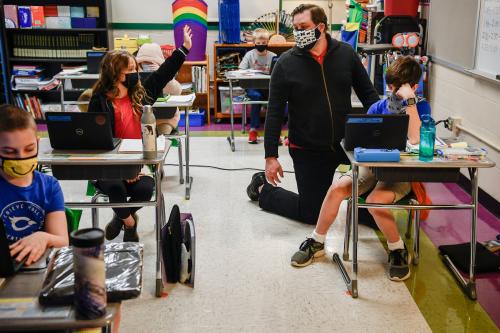Students with disabilities (SWDs) are likely to spend the majority of their school day in the general education setting. But more likely than not, their teachers have only had a single course on how best to support this student population. And while we have considerable research about how teacher quality overall is distributed within and across schools, we know comparatively little about who teaches students with disabilities, and what factors contribute to these students’ access to high-quality instruction. Nor do we know whether the persistent teacher-quality gaps across schools for students without disabilities are replicated—or worse, exacerbated—for the SWD population.
In this sense, we have left schools and districts in the dark about whether their teachers are meeting SWDs’ academic needs, as well as how they might distribute students to teachers in equitable ways. With this in mind, we see an urgent need for the field of education policy research to turn its attention more fully to questions specific to this critical student subgroup, who make up approximately 14% of the K-12 student population.
Students with disabilities are a diverse group, representing a wide range of disability subcategories. Nationwide, the most common category are students with specific learning disabilities, such as dyslexia or minimal brain dysfunction, followed by students with speech or language impairment. Despite this variation, the population of SWDs is represented relatively evenly across schools in the U.S., and nearly two-thirds of these students spend 80% or more of their day in the general education classroom. Presently, we have limited information on whether, within schools, students from each of these disability subcategories are sorted to general education teachers in equitable ways. Nor do we know whether SWDs’ access to high-quality, general education teachers changes across school contexts—which could be particularly important if teacher quality gaps were exacerbated by gaps in school disadvantage level.
There is some limited existing research on SWDs’ access to general education teacher quality. In a series of studies, Gilmour and Henry used administrative data from North Carolina to look at the sorting of SWDs into teachers’ classrooms. They found that SWDs were more likely to be in classrooms with lower-scoring peers. The authors did not see notable teacher-quality gaps between students with and without disabilities, though there was some heterogeneity in gaps across student disability subtypes. Gilmour and Wehby found that the likelihood of general educator turnover increased as the percentage of SWDs in the classroom increased. Thus, we have some evidence that schools should pay attention to how SWDs are sorted into classrooms, but further research is still necessary.
In a new study that we co-authored with Jesse Wood, Scott Imberman, and Katharine O. Strunk, we explore whether teacher-quality gaps between SWDs (in general education classrooms) and their peers without disabilities exist in a large, urban context: Los Angeles Unified School District. Los Angeles also provides a unique opportunity to explore whether there are large teacher-quality gaps when teachers have a substantial say in classroom assignment decisions. Additionally, given what is known about teacher-quality gaps across school-level factors, we explore whether these gaps vary depending on school disadvantage levels. We leverage rich administrative data from Los Angeles to examine teacher quality in four different ways: teacher value-added measures (previous year), classroom-observation-based teacher evaluation scores (previous year), teacher hiring scores, and years of experience.
Our first finding is that, overall, SWDs in general education classrooms are typically assigned to math teachers with lower value-added measure scores and lower teacher-evaluation scores than their peers without disabilities. In English classes, SWDs are typically assigned to teachers with lower teacher-evaluation scores and are more likely to be novice teachers (defined as two or fewer years of experience). Additional analysis reveals that teacher-quality gaps are driven mostly by within-school differences, rather than between-school differences. These results suggest that school-level decisions are driving many of these gaps between SWDs and their peers without disabilities.
Our second finding is that we generally do not see differences in teacher-quality gaps across different school-level disadvantaged groups. By and large, gaps in teacher quality do not seem larger or smaller in high-poverty schools. The only teacher-quality outcome that saw a large difference by school-level disadvantage group was English teachers’ evaluation scores. And interestingly, the gaps were significantly larger in the lowest-poverty schools when compared to the highest-poverty schools.
Our last finding is that teacher-quality gaps are mainly driven by students with specific learning disabilities, the largest subcategory of SWDs. When students were disaggregated by their disability type, we found that teacher-quality gaps for students with specific learning disabilities, compared to their peers without disabilities, mirrored the overall findings (e.g., math teachers with lower value-added scores and teacher-evaluation scores). However, students with autism or students with speech or language impairment either did not have any teacher-quality gaps or had gaps that worked in their favor compared to their peers without disabilities.
While the education field has advocated for SWDs to spend as much time as possible in the general education setting, little attention has been paid to the quality of education SWDs have access to in their general education classrooms. Overall, our findings suggest that SWDs are not able to consistently access the same quality of general education teachers as their peers without disabilities. Furthermore, these differences are mostly driven by within-school sorting and are felt most strongly by students with specific learning disabilities. Additional analysis broken down by grade suggest that much of gaps are driven by middle school grades (sixth through eighth grades) rather than earlier grades. Altogether, these results suggest that an immediate solution could be for middle school grades to more carefully examine how they assign SWDs to teacher, particularly students with specific learning disabilities.
These results also underline that much remains unknown about the type of education that SWDs are able to access in the general education setting. Future work should explore what, if any, factors schools take into consideration while assigning SWDs to classrooms. Additionally, future work could explore what teacher characteristics or backgrounds may be particularly well suited to effectively teaching SWDs. We look forward to more research from the field focused on what is needed to ensure SWDs are receiving an education that is “appropriately ambitious.”
The Brookings Institution is committed to quality, independence, and impact.
We are supported by a diverse array of funders. In line with our values and policies, each Brookings publication represents the sole views of its author(s).







Commentary
Do students with disabilities receive quality instruction in general education classrooms?
November 19, 2020